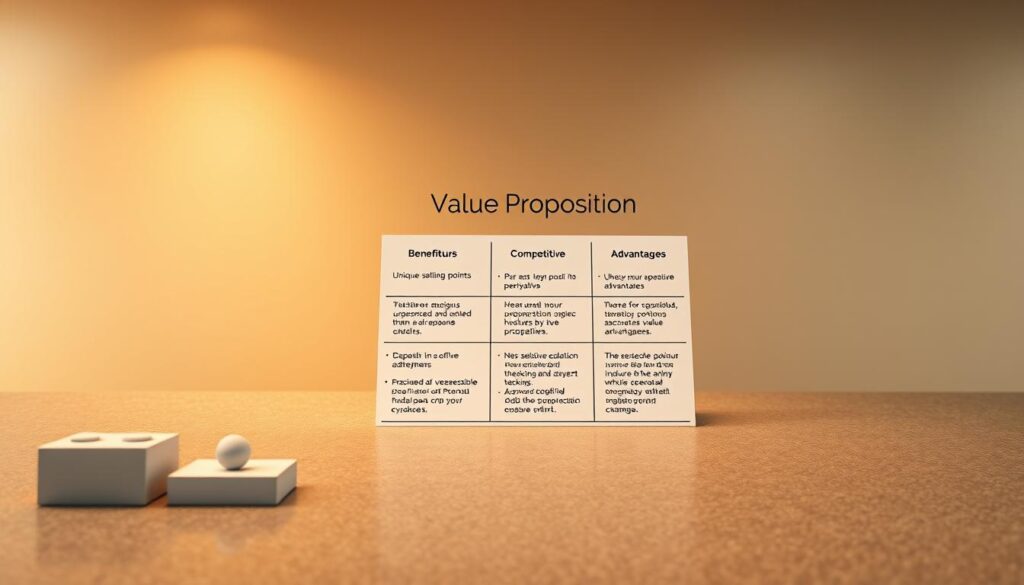Now Reading: Discover the Benefits of Strong Commercial Value with Conversion Potential
- 01
Discover the Benefits of Strong Commercial Value with Conversion Potential
Discover the Benefits of Strong Commercial Value with Conversion Potential

Every successful enterprise is built on a core principle: delivering something customers truly want. This foundational idea separates market leaders from the rest. It’s the engine that drives sustainable expansion and builds a loyal customer base.
This guide explores how a compelling offer serves as the bedrock for lasting success. It enables a company to stand out in crowded markets. The focus is on creating meaningful connections that lead to measurable outcomes.
Understanding the link between what you offer and how customers respond is powerful. It empowers leaders to make strategic choices. These decisions align products with real-world needs, opening up significant revenue opportunities.
We will examine proven frameworks used by top-performing organizations. You will learn methodologies to identify, develop, and communicate your unique advantages. These approaches have a direct impact on performance metrics and customer acquisition.
Key Takeaways
- A powerful value proposition is essential for differentiation and growth.
- Aligning offerings with customer needs maximizes revenue potential.
- Strategic frameworks can directly improve key business metrics.
- Real-world examples show significant improvements are achievable.
- Effective communication of your unique benefits drives customer action.
Introduction to Maximizing Commercial Potential
Amazon’s legendary growth story provides a masterclass in aligning a core vision with practical market execution. Jeff Bezos famously stated that Amazon is “stubborn on vision” but “flexible on details.” This philosophy fueled a rise from $20,000 in weekly sales to over $107 billion in annual revenue.
This incredible success stems from mastering two critical concepts. Understanding these elements is the first step toward similar achievements for any organization.
Overview of Commercial Value
Commercial value represents the complete package of benefits a business delivers. It includes product quality, pricing, customer service, and brand reputation. This combination directly influences why customers choose one offer over another.
Importance of Conversion Potential
Conversion potential measures a company‘s skill at turning interest into action. It involves clear communication of your value proposition and removing friction from the customer’s path. A smooth journey is essential for transforming prospects into loyal buyers.
The relationship between these two ideas is powerful. Great value attracts the right audience. An optimized conversion process ensures they complete a purchase or sign up for services.
| Concept | Primary Focus | Key Driver | End Result |
|---|---|---|---|
| Commercial Value | Benefit Creation | Customer Needs | Attraction & Interest |
| Conversion Potential | Action Facilitation | User Experience | Transaction & Loyalty |
Focusing on value creation first, as Amazon did, builds a foundation for sustainable growth. This approach consistently leads to superior market performance.
Understanding the Value Proposition
The bridge between business offerings and customer action is built on a clear, compelling promise. This statement defines why someone should choose your solution over alternatives. It answers the fundamental question every prospect asks: what makes you different?
Definition and Key Elements
A value proposition functions as a strategic promise. It identifies the specific problem your business solves while explaining why your approach stands out. This isn’t a creative slogan but a substantive declaration of purpose.
Effective propositions combine multiple elements working together. They use headlines, supporting text, and visual components to communicate clear messages. Each piece should highlight the unique benefits customers receive.

Strong propositions share essential characteristics. They target specific audience segments with tailored messaging. Every component should work toward a single goal: demonstrating superior solutions.
Impact on Conversion Rates
The connection between your proposition and conversion rates is direct. A poorly articulated message limits optimization potential regardless of other improvements. But a compelling one creates opportunities for dramatic performance gains.
When customers quickly understand your unique value, they’re more likely to take action. This clarity reduces hesitation and builds confidence in your solution. It’s why developing the right business plan template that incorporates your value proposition is so critical.
Testing and refining your proposition represents one of the most valuable marketing activities. It establishes the foundation for all other optimization efforts. Getting this element right transforms how prospects perceive your offerings.
Analyzing Your Target Audience and Customer Needs
The most brilliant value proposition will fall flat if it doesn’t connect with the right people. Many businesses create messaging they love, only to discover it misses the mark entirely. This disconnect represents one of marketing’s most expensive mistakes.
Effective communication starts with deep understanding of who you’re serving. Without this foundation, even the best creative work fails to generate meaningful results.
Identifying Customer Pain Points
Creating detailed customer personas helps uncover the real challenges your audience faces. This goes beyond basic demographics to explore deeper frustrations. You need to understand what keeps your target audience awake at night.
Different groups of customers experience unique pain points. A one-size-fits-all approach rarely works in today’s diverse market. Your messaging should address specific concerns for each segment.
The process requires ongoing attention over time. Customer needs evolve as conditions change. Regular feedback ensures your value propositions remain relevant and effective.
When you truly understand your customer base, you create propositions that resonate deeply. This alignment transforms how people perceive your offerings and drives meaningful engagement.
Crafting a Unique Value Proposition That Stands Out
Developing a standout value proposition requires more than just listing features. It demands strategic differentiation that makes your business impossible to ignore. This process begins with honest assessment of what makes your company truly distinctive.

Competitive Landscape Analysis
Understanding your competition is the essential first step. You need to research what other companies offer and identify gaps in the market. This analysis reveals opportunities for your unique value to shine.
Many businesses make the mistake of copying successful companies. But every market context is different. Your value proposition should reflect your specific strengths and capabilities.
| Approach | Focus Area | Result |
|---|---|---|
| Effective Differentiation | Specific customer problems | Higher conversion rates |
| Generic Claims | Broad market appeal | Limited impact |
| Authentic Positioning | Unique capabilities | Sustainable advantage |
Aligning Your Proposition with Customer Desires
The most powerful proposition emerges when your offer matches customer needs perfectly. This alignment creates natural appeal that drives action. It’s about solving specific problems better than anyone else.
Your product or service should address real customer pain points. The more relevant your solution, the stronger your market position. This approach transforms how people perceive your value and increases engagement.
For deeper insights into developing effective messaging, explore this comprehensive guide on value proposition development. It provides practical frameworks for creating compelling statements that resonate with your audience.
Implementing “Strong commercial value with conversion potential” on Your Website
Website integration transforms abstract value concepts into tangible customer experiences. Many businesses craft excellent propositions but struggle with digital implementation.

The disconnect between strategy and execution represents a common challenge. Your core promise must guide every website decision and element.
Website Integration Strategies
Strategic placement ensures your value proposition reaches visitors at critical moments. Each page should reinforce your unique advantages clearly.
Homepages introduce your core promise to new audiences. Product page content should demonstrate how offerings deliver specific benefits. Category page organization must reflect your differentiation strategy.
| Page Type | Integration Focus | Visitor Impact |
|---|---|---|
| Homepage | Core message introduction | First impression formation |
| Product Page | Benefit demonstration | Purchase decision support |
| Category Page | Solution organization | Navigation ease |
| Checkout Process | Confirmation reinforcement | Completion assurance |
Visual design elements should amplify rather than distract from your message. Consistent implementation across all touchpoints builds visitor trust and drives measurable conversions.
Case Studies: Real-World Examples and Testing Strategies
The gap between what businesses assume will work and what actually converts customers can be substantial. Real-world testing provides crucial insights that challenge conventional thinking.

These examples demonstrate how data-driven decisions consistently outperform assumptions. Each case reveals important patterns in customer behavior.
Educational Publisher Success Story
A technical book publisher faced high abandonment rates on their product page. They tested two variations of their value proposition.
Despite 80% of internal staff preferring one option, the other achieved a 26% conversion increase. The winning variation used “The E-Book Advantage” instead of technical terms.
Food Supplement Conversion Improvements
A supplement company tested different product page layouts. The results were dramatic.
Variation 1 achieved a 55.5% increase in conversion rates. This shows how display choices impact customer decisions.
CTA Button Testing Insights
Even small design changes can produce significant results. Button testing revealed a 17.04% conversion rate improvement.
The winning design proved that subtle modifications influence visitor behavior. These insights help optimize every page element.
Optimizing Your Website Copy and Design for Conversions
Website optimization requires a careful balance between compelling content and intuitive design elements. These components work together to guide visitors toward taking action.
The most effective websites combine clear messaging with seamless navigation. This approach transforms casual browsers into committed customers.
Effective Copywriting Techniques
Authentic language resonates far better than marketing jargon. Groove discovered this when their homepage conversion jumped 104%.
They replaced corporate speak with customer vocabulary. This simple change made their value proposition instantly relatable.
Benefit-driven headlines outperform feature descriptions. Focus on what customers gain rather than what your company offers.
Visual Enhancements and User Experience
Comnio achieved a 408% conversion increase through strategic design changes. They repositioned trust elements and simplified the signup process.
Small adjustments create significant impact. Better placeholder text and clearer call-to-action buttons reduce friction.
Testimonials placed prominently build confidence. Social login options streamline the user journey from interest to action.
Every page element should support your core proposition. This alignment drives measurable improvements in conversion rates.
Measuring and Testing Value Proposition Effectiveness
Measuring how well your business promise resonates with customers involves more than just monitoring final sales figures. It requires a comprehensive approach that tracks multiple data points throughout the customer journey.
Establishing clear hypotheses before making changes is crucial for meaningful measurement. This approach ensures your efforts produce valuable insights rather than random experimentation.
Key Performance Indicators (KPIs) to Monitor
The primary metric for assessing your proposition’s impact is conversion rate. However, several secondary metrics provide deeper understanding of visitor behavior.
Engagement metrics like time on page and scroll depth reveal how thoroughly visitors absorb your messaging. Bounce rates indicate whether your value proposition connects immediately.
| KPI Category | Specific Metrics | What It Measures | Optimization Insight |
|---|---|---|---|
| Conversion Metrics | Purchase rate, sign-up rate | Final action completion | Overall proposition effectiveness |
| Engagement Metrics | Time on page, scroll depth | Message absorption level | Clarity and relevance testing |
| Behavioral Metrics | Click-through rate, bounce rate | Initial response quality | First impression impact |
| Qualitative Metrics | Survey responses, feedback | Customer perception | Emotional connection strength |
Udemy’s experience demonstrates the power of systematic testing. Their original course pages suffered from confusing layouts that diluted their core message. Through A/B testing, they identified a clearer presentation that dramatically improved results.
Continuous testing over time ensures your value proposition remains effective as market conditions evolve. Combining quantitative data with customer feedback creates a complete picture of what resonates with your audience.
Conclusion
Market domination starts when you stop trying to appeal to everyone and focus on serving specific customer needs. This focused approach transforms how people perceive your business and drives meaningful engagement.
A compelling value proposition acts as your customers’ primary decision-making tool. The more specific your messaging, the better it resonates with your target audience. This clarity directly impacts your conversion rates.
Successful companies understand they cannot be all things to all people. Instead, they become the first choice for specific segments when it comes to particular needs. This strategic positioning creates sustainable advantage in competitive markets.
The journey requires honest self-assessment and deep customer understanding. Your proposition must reflect what your company actually delivers, not just marketing creativity. Authenticity builds trust that drives business growth.
Continuous testing ensures your messaging remains effective as market conditions evolve. Data-driven refinements help optimize every aspect of your customer experience. This ongoing commitment separates market leaders from the competition.
FAQ
What is meant by "strong commercial value with conversion potential"?
This concept describes an offer that provides significant, tangible benefits to your target audience while also being designed to motivate a specific, valuable action. It combines a compelling reason for people to choose your product or service with a clear path for them to become paying customers, directly influencing your revenue growth.
How does a value proposition impact my website’s conversion rate?
A well-defined value proposition directly influences your conversion rate by immediately answering a visitor’s key question: “What’s in it for me?” When your proposition clearly communicates unique benefits and solves customer pain points, it builds trust and reduces hesitation, guiding more visitors to take the desired action, whether it’s making a purchase or signing up.
What are the key elements of an effective value proposition?
An effective proposition typically includes a clear headline stating the primary benefit, a sub-headline or short paragraph that elaborates on the offer, and three key points that highlight the specific value, such as time saved, money earned, or a problem solved. It should be concise, customer-focused, and differentiate your business from competitors in the market.
How can I test if my value proposition is effective?
You can test its effectiveness through A/B testing. Create different versions of your headline and key benefit statements on your main landing page. Use tools like Google Optimize to serve these variations to visitors and monitor key performance indicators like conversion rates, time on page, and bounce rates to see which version resonates best with your audience.
Can you give an example of a successful value proposition test?
A notable example is when an educational publisher tested two different homepage headlines. One focused on “Comprehensive Learning Resources,” while the other emphasized “Boost Student Test Scores by 20%.” The second version, which highlighted a specific, measurable outcome for the customer, resulted in a 35% increase in free trial sign-ups, demonstrating the power of a benefit-driven proposition.
Why is understanding my target audience crucial for conversion optimization?
Knowing your audience’s specific needs, challenges, and desires allows you to tailor your value proposition and website messaging to speak directly to them. This alignment makes your offer more relevant and persuasive, significantly increasing the likelihood that visitors will convert because they feel your product or service was made specifically for them.
What role does website design play in supporting conversion potential?
Website design is critical. A clean, intuitive user experience with clear visual cues—like prominent call-to-action buttons, relevant imagery, and easy navigation—guides visitors toward conversion points. Good design reduces friction and builds credibility, ensuring that the strong commercial value of your offer is not lost due to a confusing or untrustworthy-looking website.











